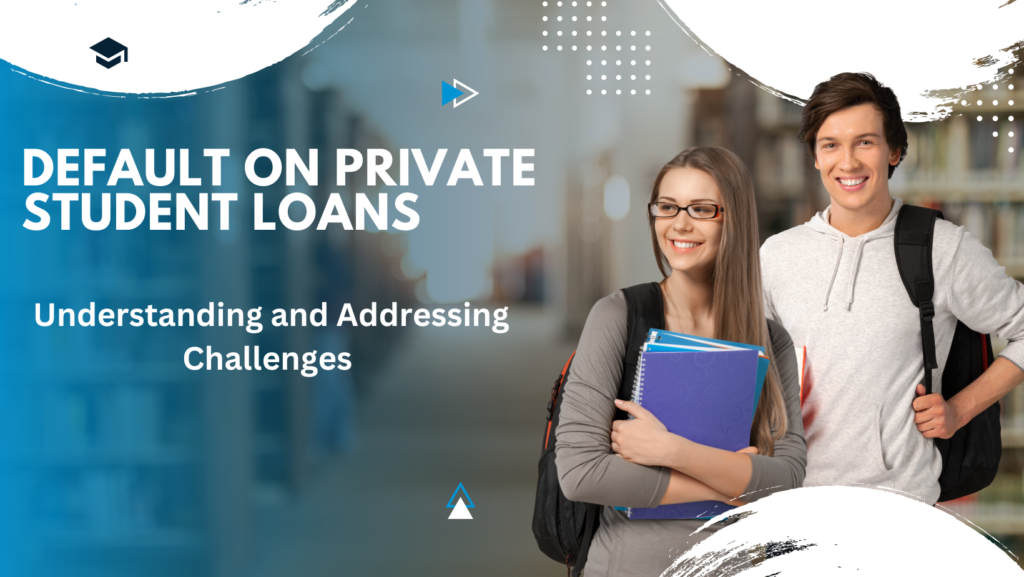Default on Private Student Loans: The pursuit of higher education often comes with hefty financial burdens. For many students, private loans become an essential means to bridge the gap between scholarships, grants, and the actual cost of education.
However, if circumstances take an unexpected turn, defaulting on private student loans can be a daunting reality. In this article, we will dissect the multifaceted challenges of defaulting on private student loans and equip you with actionable insights to overcome these challenges.
Default on Private Student Loans

The Rising Tide of Private Student Loans
Private student loans have gained significant prominence in recent years, offering students flexible options for financing their education. Unlike federal loans, private student loans are provided by banks, credit unions, and other financial institutions. While they may offer more competitive interest rates at times, these loans come with their own set of unique challenges.
Understanding the Default Mechanism
Defaulting on private student loans occurs when a borrower fails to make consistent payments within the agreed-upon terms. Once a loan enters default, it can have severe consequences for borrowers’ financial future. But what triggers this process? Let’s explore the mechanism behind default on private student loans at a closer glance.
Sub-Point 1: Delinquency and Late Payments
Private student loans generally have a grace period before payments become due, usually six months after graduation or dropping below half-time enrollment. Failing to start making payments within this grace period signifies delinquency. Late payments also contribute to this status, which may result in additional fees or penalties.
Sub-Point 2: Default Thresholds and Timing
The exact timing for defaulting on a private student loan varies depending on the lender and loan terms. However, default typically occurs after significant delinquency, often ranging from 90 to 270 days without payment. At this stage, the borrower’s credit score takes a major hit, and the loan may be transferred to a collections agency, triggering a barrage of collection attempts.
Sub-Point 3: The Consequences of Default
Defaulting on private student loans carries severe consequences that can have far-reaching implications for borrowers. These consequences include:
- Damaged Credit Score: Defaulting heavily tarnishes borrowers’ credit scores, making it challenging to secure future loans, obtain housing, or even find employment.
- Collections Proceedings: Once a loan is in default, collections proceedings can commence, resulting in lenders taking legal action, potentially garnishing wages or seeking resolution through the court system.
- Loss of Eligibility for Financial Aid: Defaulting on student loans can also render borrowers ineligible for federal financial aid, further complicating their ability to pursue higher education.
Strategies for Addressing Default Challenges
Defaulting on private student loans may seem insurmountable, but there are strategies to help borrowers navigate this difficult situation. By taking a proactive approach and exploring these strategies, individuals can regain control over their finances and rebuild their credit standing.
Sub-Point 1: Communication and Negotiation
When facing default, open communication with your lender becomes crucial. Discussing your financial hardships and exploring alternative payment plans or loan modification options can help mitigate the negative consequences. Lenders are often willing to work with borrowers to find mutually beneficial solutions.
Sub-Point 2: Loan Rehabilitation and Consolidation
Loan rehabilitation programs allow borrowers to regain control over their defaulted loans. By making a series of agreed-upon payments, borrowers can reinstate their loans’ good standing and enjoy more favorable repayment terms. Consolidation is another viable option, allowing borrowers to combine multiple loans into one, simplifying repayment.
Sub-Point 3: Seeking Professional Guidance
Navigating the complexities of defaulting on private student loans can be overwhelming. Seeking the expertise of a student loan counselor or financial advisor can provide invaluable guidance. These professionals can help borrowers explore all available options, negotiate with lenders, and develop a personalized plan for overcoming default.
Conclusion Of Default on Private Student Loans
The challenges of defaulting on private student loans can feel overwhelming, but they are not insurmountable. By understanding the mechanisms behind the default process and employing proactive strategies, borrowers can regain control over their financial future. Remember, open communication, loan rehabilitation, and seeking professional guidance can make a significant difference in overcoming default challenges. Empower yourself with knowledge, take action, and pave the way for a brighter financial future.
FAQs About Default on Private Student Loans
- What is considered a default on private student loans? Default on private student loans occurs when a borrower fails to make payments as specified in the loan agreement. Typically, this occurs after several months of missed payments.
- How many missed payments lead to default on private student loans? The specific number of missed payments that lead to default can vary among lenders, but it often occurs after 120 days of non-payment.
- What are the consequences of defaulting on private student loans? Consequences of default may include damage to the borrower’s credit score, collection efforts by the lender, potential legal actions, and the acceleration of the entire loan balance becoming due.
- Can the lender take legal action against a borrower in default on private student loans? Yes, lenders have the option to take legal action to recover the outstanding debt. This may include filing a lawsuit against the borrower.
- Can the lender garnish wages for defaulted private student loans? Yes, in some cases, the lender may seek a court order to garnish the borrower’s wages to recover the defaulted amount.
- Can the lender seize assets in the case of default on private student loans? In some instances, a lender may take legal action to seize assets as part of the debt collection process. However, this depends on the laws of the specific jurisdiction.
- Can a defaulted private student loan be settled for a reduced amount? Some lenders may be willing to negotiate a settlement for less than the full amount to resolve a defaulted private student loan. However, settlement terms vary, and it’s not guaranteed.
- Is rehabilitation an option for defaulted private student loans? Loan rehabilitation is an option for some private student loans. It typically involves making a series of agreed-upon payments to bring the loan out of default status.
- Can a defaulted private student loan be discharged in bankruptcy? Discharging student loans in bankruptcy, including private student loans, is generally challenging. Borrowers must demonstrate “undue hardship,” and approval is not automatic.
- Are there options to get out of default on private student loans? Options to get out of default may include loan rehabilitation, loan consolidation, or negotiating a new repayment plan with the lender. Borrowers should contact their loan servicer to discuss available options.
- Can a defaulted private student loan be refinanced? Refinancing a defaulted private student loan is challenging, as refinancing typically requires a good credit history. However, borrowers may explore refinancing options once they have resolved the default and improved their credit.
- How long does a default on private student loans stay on a credit report? A default on private student loans can stay on a credit report for seven years. This negative mark can significantly impact the borrower’s credit score.
- What should a borrower do if facing default on private student loans? Borrowers facing default should contact their lender immediately to discuss available options. Lenders may be willing to work with borrowers to find a solution, such as a new repayment plan or loan rehabilitation.
Also Read:
Earnest Student Loan Application
Defaulted Private Student Loan Help

